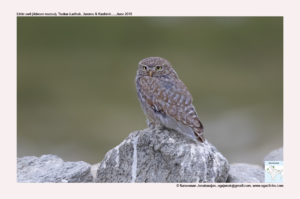
Little Owl Athena noctua
Etymology:
- Athena : Greek Mythology Athene, goddess of wisdom, war,and the liberal arts, whose favourite bird was the owl, an ancient association from her primitive role as goddess of the night
- Noctua: Latin for littlw owl sacred to goddess Minerva also known as Athena
Vernacular Names:Tibetan: Ugpa
Distribution in India: Resident of North Himalayas in India. Best place to see is in Ladhak.
Description: Size of 21–23 cm; wingspan 54–58 cm; wt. of male is 162–177 g, wt. of female is. 166–206 g. It is a compact, plump and relatively small owl, with wings that are broad and rounded; flight is undulating, with alternating bouts of flapping and closing wings. The plumage colour is variable, from grey-brown or rufous-brown to ocher-buff. Its upperparts are spotted white, underparts are splashed; facial disc obvious on dark birds. The irides are bright yellow; bill is pale yellow; legs are proportionately long, feathered, pale yellowish to white. Juvenile are distinctly paler and much more uniformly patterned than adult; spots buff, not white, and streaking narrower and paler brown.
Habitat:It is found in semi-open habitats from steppes and stony semi-desert to farmland and open woodland, villages and urban areas, extending to boreal and tropical areas.
Food habits:It eats small mammals and birds, reptiles, amphibians, beetles, crickets, earwigs and earthworms. It is nocturnal and crepuscular, mainly dusk to midnight, then break of 2 hours before resumption to dawn and is rarely diurnal. It hunts by perching on post or similar vantage point, dropping on prey; occasionally hovers; also hunts on ground. It can run rapidly while chasing prey. The larger prey are taken with feet, smaller prey with bill. The beetles are swallowed whole or sometimes held up in foot to be bitten 2–3 times, earthworms swallowed in single snap. It also accumulates prey to be eaten later.
Breeding habits: They breed in Mar–Aug in India. They are monogamous, both socially and genetically, the pair-bond often persisting all year and perhaps until partner dies. The copulation are frequent beginning in midwinter; female initiates mating whereas male solicits female to visit potential nesting sites. The Nest is a cavity, hole cleaned and hollow scraped. They lay a clutch of 3–6 eggs, usually laid at 2-day intervals. The incubation period is 28–33 days done by female,. The female broods until young are 14 days old, leaving nest only for brief periods, relying on male for food. Both sexes feed the young. The fledge period is 30–35 days, cared for and fed by both parents for 1 month after fledging.